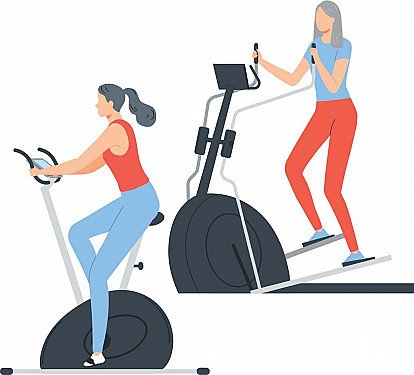Push past your resistance to strength training
For a heart-healthy workout, include reps as well as steps.
- Reviewed by Christopher P. Cannon, MD, Editor in Chief, Harvard Heart Letter; Editorial Advisory Board Member, Harvard Health Publishing

If weight training (also called strength or resistance training) makes you think of body builders hoisting heavy weights in a gym, think again. You can tone and build muscle in the privacy of your home — no special equipment needed. And you should make it a regular habit because resistance training is good for your entire body, including your heart.
"Many middle-aged and older adults are aware that heart health is extremely important. But they tend to connect cardiovascular fitness mainly with aerobic exercise, such as brisk walking, jogging, and cycling," says Dr. Beth Frates, a clinical assistant professor in the Department of Physical Medicine and Rehabilitation at Harvard Medical School. However, combining both aerobic and resistance training offers the best protection against early death in general, and from heart-related causes in particular, she says.
A recent scientific statement from the American Heart Association (AHA), published Jan. 16, 2024, in the journal Circulation, details the heart-related benefits of resistance training. Doing resistance training on a regular basis can improve your blood pressure, blood sugar, blood lipids, and body composition. It's especially beneficial for older adults and people with an elevated risk for heart problems.
Bonus benefits of resistance training
Resistance training has also been shown to improve other factors closely tied to cardiovascular health. For example, it enhances blood vessel function, in part by keeping your arteries flexible. Resistance training also appears to lower levels of inflammation, which ignites the damaging, body-wide process that contributes to clogged arteries. But while you won't be able to feel those effects, you may experience noticeable improvements in both your sleep and your mood after adding strength-building exercises to your workout, says Dr. Frates. Both inadequate sleep and stress can contribute to cardiovascular problems.
Resistance training also supports weight loss because it burns calories both during and after your workout. When people lose weight, they usually lose muscle mass along with fat; weight training helps preserve muscle mass. Given the popularity of effective weight-loss medications known as GLP-1s, such as semaglutide (Wegovy) and tirzepatide (Zepbound), it's important to recognize that muscle wasting (loss of muscle mass) is a possible side effect of these drugs, says Dr. Frates. That means resistance exercise is especially vital for people taking these medications.
Getting started
If you're new to this form of exercise, keep an open mind, says Dr. Frates. A good first step is visit a fitness center or gym and meet with a trainer, just to get a sense of the range of options for building strength. You can use machines, resistance bands, hand weights, or your own body weight. "Take time to explore them all as a curious child might explore the outdoors," says Dr. Frates. Consider a trial membership to see how it feels to use the machines and other equipment.
Another option is to seek out a supervised program at a senior center with a certified instructor who can teach you proper form, which is key to avoiding injury. If you have any mobility limitations due to arthritis or other health conditions, consider getting a referral to a physical therapist who can create a safe regimen tailored specifically to your needs.
While the camaraderie of in-person classes can be motiving and fun, you can't beat the convenience of exercising at home on your own, Dr. Frates says. You can find free online exercise videos on YouTube. Use a search term like "older adult strength training," and look for videos that clearly demonstrate the proper form, like those from the National Institute on Aging; see these exercises on YouTube.
Sample exercises for all major muscles groupsThe following examples are from the AHA's scientific statement on resistance training. You don't need to do all the exercises in each training session — just try to rotate through the different major muscle groups and work all or most of them over the course of a week or two. For additional examples that don't require any equipment, see Harvard Health Publishing's Special Health Report Body-Weight Exercise. |
|
|
Major muscle group |
Example exercises |
|
Pectoralis (chest) |
Chest press; push-up |
|
Deltoids (shoulder) |
Shoulder raise: shoulder press two ways |
|
Rhomboids (upper back) |
Upright row: deadlift back row |
|
Triceps (back upper arm) |
Triceps extension |
|
Biceps (front upper arm) |
Biceps curl |
|
Quadriceps (front thigh); Hamstrings (back thigh); Gluteals (buttocks) |
Squat: lunge |
|
Calf (back lower leg) |
Calf raises |
|
Abdominal |
Abdominal crunch: low plank; full plank |
|
Back |
Back extension |
How much, how often?
Aim for two strength-boosting sessions per week, which need only last about 15 to 20 minutes each. The AHA recommends focusing on eight to 10 different exercises (see "Sample exercises for all major muscle groups") to get a balanced workout. Set a goal of completing eight resistance training sessions in a month, marking the days on a calendar and tracking the number of repetitions (reps) you do of each exercise, Dr. Frates suggests. And it's often more motivating — and fun — if you can enlist a friend or family member to join you, she adds.
Image: © ViewStock/Getty Images
About the Author

Julie Corliss, Executive Editor, Harvard Heart Letter
About the Reviewer

Christopher P. Cannon, MD, Editor in Chief, Harvard Heart Letter; Editorial Advisory Board Member, Harvard Health Publishing
Disclaimer:
As a service to our readers, Harvard Health Publishing provides access to our library of archived content. Please note the date of last review or update on all articles.
No content on this site, regardless of date, should ever be used as a substitute for direct medical advice from your doctor or other qualified clinician.
















